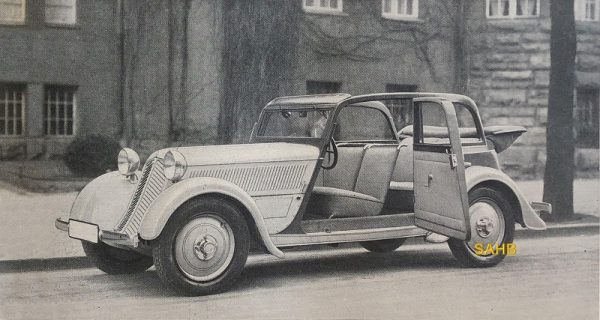
This smart “Convertible Victoria” may seem to be a desirable small car – but the model was destined to be the last car made by NAG and sold no more than 400 examples.
The Neue Automobil-Gesellschaft (NAG), or Nationale Automobil-Gesellschaft after it changed its name in 1915, was a Berlin-based car maker. The business started in 1902 when the German electrical company AEG bought the coachbuilding branch of Kühlstein, under engineer Joseph Vollmer, and renamed it NAG. After producing some reliable but conventional cars, AEG got out of the car business and NAG continued alone. They produced the four-cylinder 1502cc Puck that won the Gothenburg Cup at the Swedish Winter Trials three years in a row, in 1912, 1913 and 1914. From 1911 to 1914 NAG built a range of cars with engines from 1502cc to 8495cc, but suffered badly postwar and partnered with Brennabor, Lloyd and Hansa to form the GDA sales organisation in an attempt to ensure their survival. After moderate success with road and racing cars, NAG bought fellow Berlin car maker Protos in 1926 and Presto in 1927. Sadly, none of the cars were sufficiently different from those from other German makers, and sales did not take off.
NAG therefore gambled on a straight-eight, abandoned because of crankshaft whip, and then in 1929 hired former Impéria and Steiger designer Paul Henze, who created a 4540cc V8 and installed it in an existing NAG chassis to create the Typ 218/219. With bodies by Drauz they were good-looking machines that competed with the Mercedes-Benz Mannheim model but were more expensive. No more than 50 were sold.
In a last desperate push for success NAG took over the small Voran concern (short for Vorderradantrieb – front-wheel drive). With it came their designer and front-wheel drive expert Richard Bussien. He turned Henze’s V8 round and installed it to drive the front wheels in a backbone chassis with all-round independent suspension; this became the Typ 212. It was, however, too advanced for the depression years and never made production.
And now we come to the car in our Snapshot. NAG completely abandoned the idea of a luxury car and instead in 1933 created a small front-wheel drive car, the NAG-Voran 220,with a flat-four air-cooled engine of 1484cc developing 30bhp. It had chassisless construction with a wooden body panelled in fabric, and Lancia-style sliding-pillar front suspension. It was advanced and well thought out, but by now NAG had parlous finances and an old-fashioned ill-equipped factory. Only 383 were built before NAG withdrew from car production in August 1934.
NAG had merged with the heavy-vehicle company Büssing in 1931 and the name NAG-Büssing survived for a further 15 years on trucks and buses.







Leave a Comment